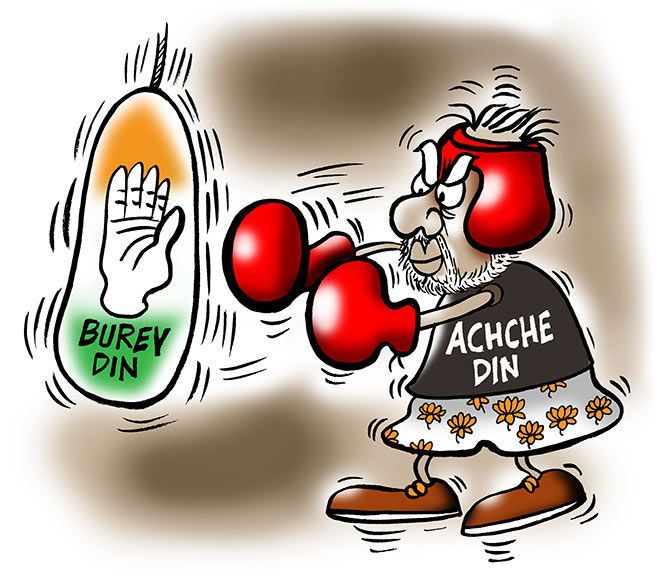More people felt optimistic about their economic condition in November than in the same month a year ago, says Mahesh Vyas.
Illustration: Uttam Ghosh/Rediff.com
 <
<
The prime minister should be pleased with the economy’s performance in November 2017.
I say this because recently he expressed concern about the spread of negativity and the need to focus on positive developments. He has a point, even if with a small limitation.
A feeling of optimism and positivity can aid the process of progress as much as negativism can be counterproductive.
Attitude is a necessary, if not a sufficient condition, for desired outcomes.
November offered much on positive developments and therefore much to be optimistic about.
During November, India’s rank in Ease of Doing Business went up to 100 among 190 countries, compared to a much lower rank of 130 a year ago and 142 the year before that; rating agency Moody’s scaled up India’s sovereign rating from the lowest investment grade of Baa3 to Baa2 and changed the outlook from stable to positive; GDP growth numbers lived up to expectations of a revival as it improved from 5.7 per cent in the first quarter of the current fiscal to 6.3 per cent in the second quarter; corporate results have been better than in the past, and the government has simplified GST.
The BSE-CMIE-UMich Consumer Sentiments Index joined in the positivity with a 3.2 per cent rise during November.
It is not common for the index to rise by more than 3 per cent in a month. The index has mostly been on a declining trend. Positivity has been admittedly rare. And, November has been a good exception to the rule.
The index of current economic conditions, which essentially measures the assessment of households regarding their economic well-being, compared to a year ago, increased by 2.8 per cent during November.
The index tells us that a greater proportion of people in November believed that their current economic conditions are better than they were a year ago.
Therefore, this is a measure of the degree of general optimism amongst households and not a measure of an increase in the money value of well-being as is understood by, say, income.
Households also believed, more strongly than earlier, that their economic conditions would improve in the future.
The index of consumer expectations increased by 3.5 per cent.
Again, this is about the proportion of households that believe that the future looks promising compared to those who see the future differently.
Sentiments improved in both, urban and rural areas.
The index of consumer sentiments for urban areas increased by 2.3 per cent and, the index for rural areas increased by a much higher 3.6 per cent. Rural folks are more optimistic than urbanites.
However, during November both gained more confidence in the future than in their assessment of their current economic conditions.
The positive consumer sentiments of November were matched with a stop to the rising trend in unemployment rates.
The unemployment rate had been rising steadily since its low-point of 3.4 per cent in July 2017.
Since then, it rose to 4.1 per cent in August, 4.5 per cent in September and 5.7 per cent in October.
This rising progression was halted in November, which recorded a lower unemployment rate of 4.6 per cent.
The trend in unemployment was the same in rural and urban areas. The rate had risen in every month since July 2017 but, this progression was halted in November 2017.
The November unemployment rate was modest at 5.3 per cent in urban India and at 4.2 per cent in rural India.
Recent weekly estimates show that the unemployment rate is declining in rural India and is broadly stable in urban India.
As a result, overall unemployment rate is declining mildly. Both, its level and its trend are in the comfort zone.
However, labour participation continues to remain weak. At around 43-44 per cent, it is much lower than the 47 per cent levels in the first half of 2016.
Urban labour participation rate has fallen from 45 per cent to 41 per cent.
Consumer sentiments are still lower than their base levels of September-December 2015.
While consumer sentiment improved remarkably in November, it did decline during the weeks of November 26 and December 3.
It is important to build upon the positive developments of November.
Sentiments and expectations about the future play an important role in consumer spending.
And, enthusiastic consumer spending is the best solution for reviving growth - or accelerating the turnaround seen in the second quarter GDP growth.
Mahesh Vyas is managing director and CEO, Centre for Monitoring Indian Economy P Ltd.












 © 2025
© 2025